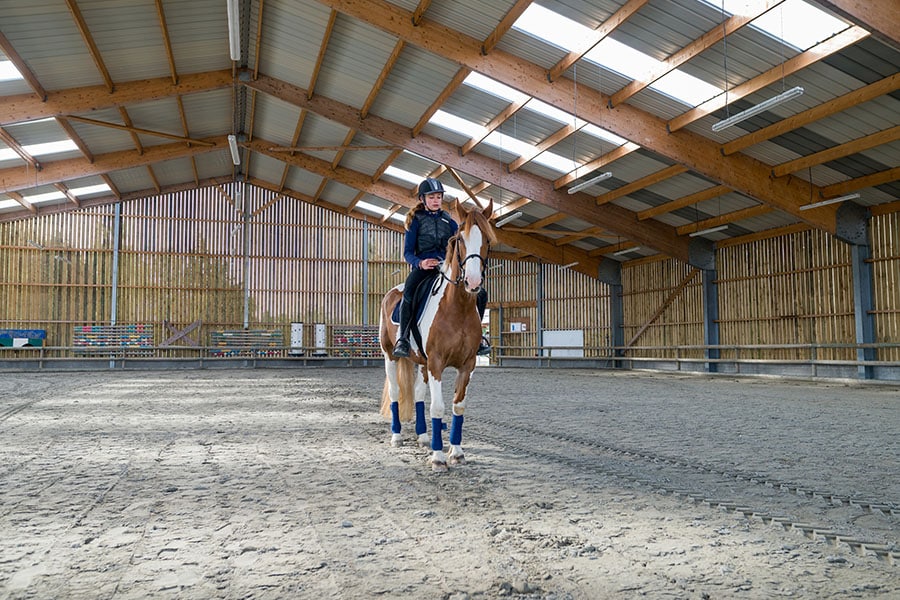Building a dressage facility can be daunting if you’re unfamiliar with the sport.
Competition horses and riders must face off on a specific dressage arena size. Usually, equestrians train their horses on the same dimensions to have an edge during competition.
However, some dressage champions have different opinions and may even practice in smaller facilities.
We’ll tell you about what size is a standard dressage arena and how big you should build a facility.
Then, you can learn more about the dressage debate and see whether you want to shorten the dimensions.
Small Dressage Arena vs. Standard Dressage Arena
When competitive riders give different dressage arena measurements, it can be confusing to know how to construct it. And can be more cost-friendly to build a smaller arena if you’re following a budget.
You’ll find small and standard dressage arenas that equestrians practice in daily.
They differ in length and width from each other, but some may prefer condensed training grounds before the event.
Standard Dressage Arena
The United States Equestrian Federation (USEF) sets the rules and regulations for national dressage competitions. They mandate competition arenas to be 20 meters by 60 meters (66 feet by 198 feet).
Dressage horses have plenty of room to perform complex movements and compete for the prize. These animals can improve their skills through dressage tests and prepare for the big event.
Small Dressage Arena
During training season, professional riders often ride on 20-meter by 40-meter facilities (66 feet by 131 feet). The USEF may prohibit this while going head-to-head, but they can freely train on it.
Equestrians practice with two 20-meter circles rather than three and still do fine when they transfer to a larger arena. So there is room to change to the long sides of your dressage facility.
How Big Should You Build a Dressage Arena?
The question of how big you build a dressage arena comes down to a rider’s preference. When entering a national event, they must abide by USEF guidelines.
But they have free reign to choose whether to train on that size or different dimensions. Some world-class champions believe smaller arenas are best for productive training sessions.
For example, Klaus Balkenhol has a beautiful indoor training facility for dressage in Rosendahl, Germany. It’s shorter than the standard length, and other reputable dressage trainers would agree with the altered length.
Overall, we recommend building no bigger than the standard size (20m x 60m). Some equestrians have trained in larger arenas but couldn’t adapt to the geometry of the competition facility.
The width is not flexible since competition horses need enough width to pivot on the footing surface’s short side. But you can extend the long side of the arena with the help of an arena specialist.
Other Arena Sizes for Competitive Riders
Each equestrian discipline differs in arena sizes, so you’ll want to consider other dimensions when building for jumping and hunting.
While the sports may be similar, you’ll find different specifications between competitions and training facilities and indoor and outdoor arenas.
The USEF also decides jumping and hunting arena sizes. Following these dimensions helps you appeal to your target discipline and draw that audience into the doors.
Our team suggests building a 20,000-square-foot arena (100 feet by 200 feet) for those sports. It’s a safe arena size for most hunting and jumping riders, satisfying most of the outdoor and indoor arena requirements.
| Hunter | Premier | National | Regional I | Regional II | Local |
| Jumper | Level 5/6 | Level 3/4 | Level 2 | – | Level 1 |
| Outdoor competition ring size | 28K sq. ft. | 28K sq. ft. | 24K sq. ft. | 20K sq. ft. | 20K sq. ft. |
| Indoor competition ring size | 20K sq. ft. | 18K sq. ft. | 16K sq. ft. | 14K sq. ft. | 14K sq. ft. |
| Outdoor exercise arena size | 24K | 20K sq. ft. | 16K sq. ft. | N/A | N/A |
| Indoor exercise arena size | 18K sq. ft. | 18K sq. ft. | 16K sq. ft. | N/A | N/A |
Do You Have the Right Dressage Base & Footing?
Standard and small dressage arena sizes are crucial for reaching niche riders. They must practice on arena dimensions that help their horses to perform their best.
However, you’ll also need to consider other factors when building the arena, such as competition standards for horse footing too. Installing the incorrect riding surface could cause injury and end a dressage animal’s career.
Equestrians lose $15,000 to $30,000 on the horse alone, not including the years of training and care they contributed.
We’re an equestrian-led staff that intimately understands dressage riders and their facility needs. Our team would be glad to answer any questions you have and even offer insight into arena construction.
To start building a top-of-the-line dressage arena, call us at (877)-835-0878.
